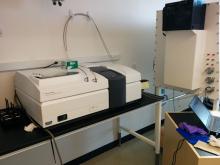Optical spectrometers allow for quantitative information concerning electronic transitions in the UV, Visible, and Infrared region. It is a key technique to monitor reactions optically, and quantify concentrations. We have multiple UV-Vis/IR spectrometers, with some coupled through fiber optics into N2 gloveboxes for air-free measurements.
Agilent 8452 (x2) – Diode-array spectrometers capable of measuring wavelengths from 200 to 1100 nm. Equipped with an 8-cuvette sample changer with the ability to perform kinetic measurements with multiple scans per second.
Cary 5000 (Agilent) – Measures wavelengths from 175 to 3300 nm. Holders include a probe for standard 1cm cuvettes, a solid-state holder, and fiber optic coupler. Coupled into the glovebox using fiber optics.
Cary 60 (Agilent)- Measures wavelengths from 175 to 1100 nm. Holders include a probe for standard 1cm cuvettes, a solid-state holder, and fiber optic coupler. Coupled into the glovebox using fiber optics.
Olis Clarity- Spectrometer designed to measure turbid samples, equipped with an NMR-tube adapter for air-sensitive samples.
Unisoku Uv-Vis- Cryostat adapted for Agilent 8453 spectrometers. Temperature capability from -80 to 100 oC easily adjusted with LN2.
Alpha IR – Compact IR spectrometer used in the glovebox. Equipped with ATR attachment and standard IR cell holder. Currently run with a CaF2 solution cell.


















